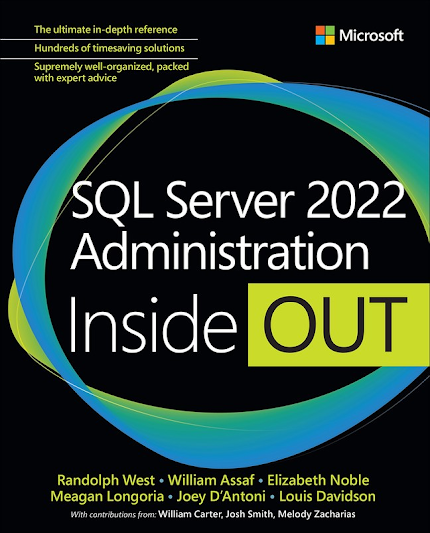Mastering SQL Server 2022 Administration: From the Inside Out
Conquer SQL Server 2022 and Azure SQL administration from the inside out!
Dive into SQL Server 2022 administration and grow your Microsoft SQL Server data platform skillset.
This well-organized reference packs in timesaving solutions, tips, and workarounds, all you need to plan, implement, deploy, provision, manage, and secure SQL Server 2022 in any environment: on-premises, cloud, or hybrid, including detailed, dedicated chapters on Azure SQL Database and Azure SQL Managed Instance.
Nine experts thoroughly tour DBA capabilities available in the SQL Server 2022 Database Engine, SQL Server Data Tools, SQL Server Management Studio, PowerShell, and much more.
You'll find extensive new coverage of Azure SQL Database and Azure SQL Managed Instance, both as a cloud platform of SQL Server and in their new integrations with SQL Server 2022, information available in no other book.
Here are 15 multiple-choice questions (MCQs) with answers related to SQL Server 2022 administration, along with some code examples.
MCQs:
Which SQL Server component is responsible for managing and controlling access to the database?
a) SQL Server Engine
b) SQL Server Management Studio
c) SQL Server Analysis Services
d) SQL Server Integration Services
Answer: a) SQL Server Engine
What SQL Server feature allows you to automate common administrative tasks and processes?
a) SQL Server Reporting Services
b) SQL Server Agent
c) SQL Server Analysis Services
d) SQL Server Integration Services
Answer: b) SQL Server Agent
Which SQL Server tool is used to configure, manage, and monitor SQL Server instances?
a) SQL Server Profiler
b) SQL Server Data Tools
c) SQL Server Configuration Manager
d) SQL Server Query Analyzer
Answer: c) SQL Server Configuration Manager
Which SQL Server statement is used to create a new database?
a) CREATE DATABASE
b) ADD DATABASE
c) CREATE TABLE
d) ADD TABLE
Answer: a) CREATE DATABASE
What is the purpose of the SQL Server SELECT statement?
a) To update data in a table
b) To insert data into a table
c) To retrieve data from a table
d) To delete data from a table
Answer: c) To retrieve data from a table
In SQL Server, which statement is used to modify data in an existing table?
a) INSERT INTO
b) DELETE FROM
c) UPDATE
d) ALTER TABLE
Answer: c) UPDATE
Which SQL Server tool allows you to perform backups and restores of databases?
a) SQL Server Configuration Manager
b) SQL Server Management Studio
c) SQL Server Agent
d) SQL Server Profiler
Answer: b) SQL Server Management Studio
What is the purpose of a SQL Server index?
a) To sort data in a table
b) To encrypt data in a table
c) To optimize data retrieval from a table
d) To group data in a table
Answer: c) To optimize data retrieval from a table
Which SQL Server system database contains information about the entire SQL Server instance?
a) msdb
b) tempdb
c) master
d) model
Answer: c) master
What is the primary role of the SQL Server Error Log?
a) To store user data
b) To record information about SQL Server errors and events
c) To store backup files
d) To store query plans
Answer: b) To record information about SQL Server errors and events
In SQL Server, what is the purpose of a stored procedure?
-----------------------------------------------
a) To execute a single SQL statement
b) To store and execute a sequence of one or more SQL statements
c) To execute queries against external data sources
d) To generate reports
Answer: b) To store and execute a sequence of one or more SQL statements
Which SQL Server command is used to remove a table from the database?
a) DELETE
b) TRUNCATE
c) DROP
d) REMOVE
Answer: c) DROP
What SQL Server feature allows you to roll back a transaction if an error occurs during execution?
a) COMMIT
b) ROLLBACK
c) SAVEPOINT
d) TRUNCATE
Answer: b) ROLLBACK
What is the purpose of a SQL Server trigger?
a) To perform a scheduled task
b) To respond to specific database events
c) To generate random data
d) To execute a SELECT statement
Answer: b) To respond to specific database events
Which SQL Server statement is used to add a new column to an existing table?
a) CREATE TABLE
b) ALTER TABLE
c) ADD COLUMN
d) UPDATE TABLE
Answer: b) ALTER TABLE
Code Examples:
********************************
sql
-- Create a new database
CREATE DATABASE MyNewDatabase;
-- Update data in a table
UPDATE Employees
SET Salary = Salary * 1.1
WHERE Department = 'Sales';
-- Create a stored procedure
CREATE PROCEDURE sp_GetEmployeeInfo
AS
BEGIN
SELECT FirstName, LastName, Salary
FROM Employees;
END;
-- Create a new table
CREATE TABLE Products
(
ProductID INT PRIMARY KEY,
ProductName NVARCHAR(255),
Price DECIMAL(10, 2)
);
-- Add a new column to an existing table
ALTER TABLE Employees
ADD Email NVARCHAR(255);
These MCQs and code examples cover various aspects of SQL Server administration. Use them as a resource to help you prepare for SQL Server 2022 administration tasks and exams.
Discover how experts tackle today's essential tasks and challenge yourself to new levels of mastery.
- Identify low-hanging fruit and practical, easy wins for improving SQL Server administration
- Get started with modern SQL Server tools, including SQL Server Management Studio, and Azure Data Studio
- Upgrade your SQL Server administration skillset to new features of SQL Server 2022, Azure SQL Database, Azure SQL Managed Instance, and SQL Server on Linux
- Design and implement modern on-premises database infrastructure, including Kubernetes
- Leverage data virtualization of third-party or non-relational data sources
- Monitor SQL instances for corruption, index activity, fragmentation, and extended events
- Automate maintenance plans, database mail, jobs, alerts, proxies, and event forwarding
- Protect data through encryption, privacy, and auditing
- Provision, manage, scale and secure, and bidirectionally synchronize Microsoft's powerful Azure SQL Managed Instance
- Understand and enable new Intelligent Query Processing features to increase query concurrency
- Prepare a best-practice runbook for disaster recovery
- Use SQL Server 2022 features to span infrastructure across hybrid environments




Comments
Post a Comment